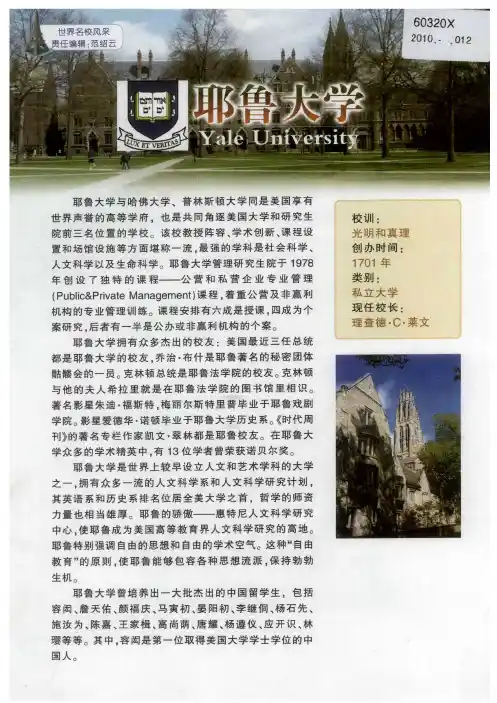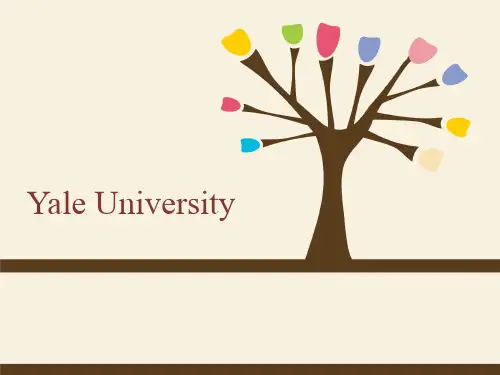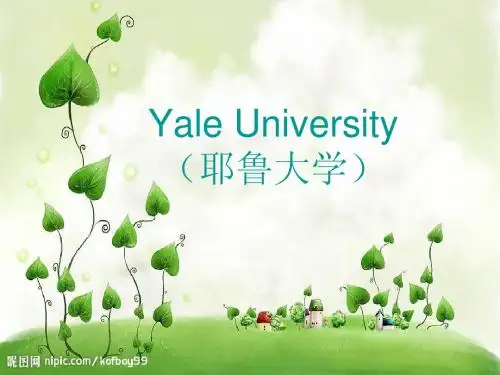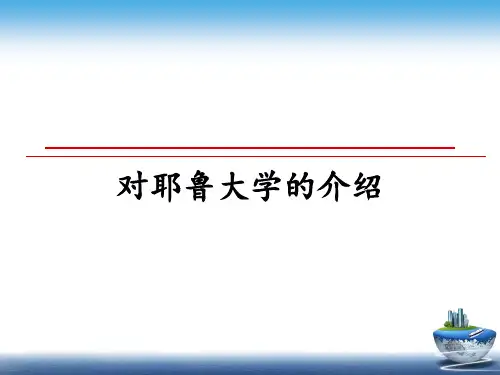耶鲁大学PPT简介
- 格式:ppt
- 大小:3.20 MB
- 文档页数:34



Yale UniversityYale University comprises three major academic components: Yale College (the undergraduate program), the Graduate School of Arts and Sciences, and the professional schools. In addition, Yale encompasses a wide array of centers and programs, libraries, museums, and administrative support offices. Approximately 11,250 students attend Yale.You are invited to view an illustrated timeline of Yale’s history in addition to reading the brief overview on this pageYale’s roots c an be traced back to the 1640s, when colonial clergymen led an effort to establish a college in New Haven to preserve the tradition of European liberal education in the New World. This vision was fulfilled in 1701, when the charter was granted for a school “wherein Youth may be instructed in the Arts and Sciences [and] through the blessing of Almighty God may be fitted for Publick employment both in Church and Civil State.” In 1718 the school was renamed “Yale College” in gratitude to the Welsh merchant Elihu Yale, who had donated the proceeds from the sale of nine bales of goods together with 417 books and a portrait of King George I.Yale College survived the American Revolutionary War (1775–1783) intact and, by the end of its first hundred years, had grown rapidly. The nineteenth and twentieth centuries brought the establishment of the graduate and professional schools that would make Yale a true university. The Yale School of Medicine was chartered in 1810, followed by the Divinity School in 1822, the Law School in 1824, and the Graduate School of Arts and Sciences in 1847 (which, in 1861, awarded the first Ph.D. in the United States), followed by the schools of Art in 1869, Music in 1894, Forestry & Environmental Studies in 1900, Nursing in 1923, Drama in 1955, Architecture in 1972, and Management in 1974.International students have made their way to Yale since the 1830s, when the first Latin American student enrolled. The first Chinese citizen to earn a degree at a Western college or university came to Yale in 1850. Today, international students make up nearly 9 percent of the undergraduate student body, and 16 percent of all students at the University. Yale’s distinguished faculty includes many who have been trained or educated abroad and many whose fields of research have a global emphasis; and international studies and exchanges play an increasingly important role in the Yale College curriculum. The University began admitting women students at the graduate level in 1869, and as undergraduates in 1969.Yale College was transformed, beginning in the early 1930s, by the establishment of residential colleges. Taking medieval English universities such as Oxford and Cambridge as its model, this distinctive system divides the undergraduate population into twelve separate communities of approximately 450 members each, thereby enabling Yale to offer its students both the intimacy of a small college environment and the vast resources of a major research university. Each college surrounds a courtyard and occupies up to a full city block, providing a congenial community where residents live, eat, socialize, and pursue a variety of academic and extracurricular activities. Each college has a master and dean, as well as a number of resident faculty members known as fellows, and each has its own dining hall, library, seminar rooms, recreation lounges, and other facilities.Today, Yale has matured into one of the world’s great universities. Its 11,000 students come from all fifty American states and from 108 countries. The3,200-member faculty is a richly diverse group of men and women who are leaders in their respective fields. The central campus now covers 310 acres (125 hectares) stretching from the School of Nursing in downtown New Haven to tree-shaded residential neighborhoods around the Divinity School. Yale’s 260 buildings include contributions from distinguished architects of every period in its history. Styles range from New England Colonial to High Victorian Gothic, from Moorish Revival toco ntemporary. Yale’s buildings, towers, lawns, courtyards, walkways, gates, and arches comprise what one architecture critic has called “the most beautiful urban campus in America.” The University also maintains over 600 acres (243 hectares) of athletic fields and natural preserves just a short bus ride from the center of town.Yale’s charter of 1701 was amended by the Connecticut Legislature in 1792 to provide that the President and Fellows of Yale College would be known as “The Corporation” and “shall have the government, care and management of the college.” Today the Corporation is made up of nineteen members: the President of the University, ten Successor Trustees, six Alumni Fellows, and two members ex officio. There are eight Officers including the President. In addition, an officer-level position of Vice President for West Campus Planning and Program Development was established on October 1, 2008, for a three-year term. The duties and responsibilities of the Fellows and Officers are set forth in the Yale Corporation By-Laws.Since 1701 with the adoption by the Connecticut Legislature of the Charter “to erect a Collegiate School,” Yale University has been guided by the Charter, including subsequent amendments, the By-Laws of the Corporation first promulgated in 1795, and the Miscellaneous Regulations which codified a series of policies and procedures such as the Alumni Fellow election process, protection of the Yale name, and patentprotection. The By-Laws and Miscellaneous Regulations may be amended from time to time upon vote of two-thirds of the Fellows. In addition, throughout Yale’s history the President has appointed committees to explore important topics, and the recommendations of those committees shaped and influenced Yale’s governance a nd administration. These historic documents and reference materials may be accessed at the links provided.This site is intended to provide links to many University-wide policies grouped under commonly understood subject headings. The listing of links on this site provides access to many available policies but should not be relied upon as a comprehensive listing of all of the University’s policies. In each case, additional information about the existence or applicability of policies may be obtained from the Web sites of the schools and divisions of the University; links to the Web sites of all of the schools and certain divisions of the University are provided below. Please note that all policies remain subject to revision.The University’s annua l operating budget of almost $2 billion is overseen by the Office of Finance & Business Operations. A financial report is issued annually. The Yale endowment is overseen by the Investments Office. The endowment provides a significant percentage of the Univ ersity’s operating income.。


大学简介近年来耶鲁大学出来多位政治领袖人物,包括最近的三位总统。
耶鲁大学的学风自由,学生思想活越,是华人孩子喜欢的著名大学之一。
另外,从2000年起,耶鲁大学从“提前决定申请”改成“提前申请”。
其中的差别是,如果你提出“提前决定申请”,那就等于你同意并许诺:一旦你被录取,比就必须答应一定要接受这个录取决定,还有一定的选择余地的。
当然,耶鲁大学这一改变更加吸引优秀学生土地申请,因为这样就不必担心被“提前决定申请”束缚住。
耶鲁位于康涅狄格州(Connecticut)的纽黑文市(New Haven),是美国东海岸上的一个小镇,距纽约不到100英里。
纽黑文市(New Haven)位于纽约和波士顿之间,所以气候也是介于两个城市的气候之间。
四季分明,空气湿润适度。
耶鲁的校园美丽、整洁,一座座古老的欧洲城城堡式建筑,美不胜收。
美中不足的是,校区被低收入非洲裔居住区包围,校园外的安全让人担忧。
在美国,耶鲁大学和哈佛大学和普林斯顿大学其名,被认为是美国乃至世界上最好的学府。
她的本科生教育近年来由于大量投资修建宿舍等设施,格外引人瞩目;她的法学院、商学院、自然科学及人文政治学科的教育与学术水平与哈佛相媲美、为了创造出优异的成绩,每年16亿多美元的开支也是打得让我们难以置信。
耶鲁大学本科生分成12个分院,每个分院有自己独立的宿舍、教师、食堂等设备。
一个学院内的学生四年内都在一起,可以结下深厚的感情。
这有点儿像哈利. 波特电影中的学院,每个学院各有千秋。
自然,学院之间的竞争也非常激烈。
不知是不是因为培养出这么多总统、大法官的缘故,耶鲁大学近两年来成为新生的最爱。
想进入耶鲁大学,您还真需要好好地努力、认真地表现才行、世纪之交,理查德. 布劳德海德(Richard H. Brodhead)是耶鲁大学本科学院的院长。
在他任期内,耶鲁本科学院大有起色,是他在美国本科教育界享有盛誉。
2004年布劳德海德被聘为杜克大学的校长、耶鲁大学本科教育的改革是美国教育界的一个经典话题。






耶鲁大学(Yale University),旧译“耶劳大书院”,是一所坐落于美国康乃狄格州纽黑文市的私立大学,始创于1701年,初名“大学学院”(Collegiate School)。
耶鲁大学是美国历史上建立的第三所大学,今为常青藤联盟的成员之一。
耶鲁大学由三个主要的学术部分组成:耶鲁学院(本科),艺术和科学研究生院和专业学校。
大约有11,250名学生就读耶鲁大学。
该校教授阵容、学术创新、课程设置和场馆设施等方面堪称一流。
校园建筑以歌特式和乔治王朝式风格的建筑为主,多数建筑有百年以上的历史。
古典建筑和少数现代风格的建筑交相互映,把整个校园点缀得十分古典和秀丽。
讲师:Robert J. Shiller
课程:金融市场
讲师:Shelly Kagan
课程:哲学死亡
讲师:Donald Kagan
课程:古希腊历史简介
讲师:Craig Wright
课程:聆听音乐
讲师:Stephen C. Stearns 课程:进化,生态和行为原理
讲师:W. Mark Saltzman
课程:生物医学工程探索
讲师:Langdon Hammer
课程:现代诗歌
讲师:Giuseppe Mazzotta
课程:解读但丁
讲师:Steven B. Smith
课程:政治哲学导论
讲师:Amy Hungerford
课程:1945年后的美国小说。
Yale UniversityYale University comprises three major academic components: Yale College (the undergraduate program), the Graduate School of Arts and Sciences, and the professional schools. In addition, Yale encompasses a wide array of centers and programs, libraries, museums, and administrative support offices. Approximately 11,250 students attend Yale.You are invited to view an illustrated timeline of Yale’s history in addition to reading the brief overview on this pageYale’s roots c an be traced back to the 1640s, when colonial clergymen led an effort to establish a college in New Haven to preserve the tradition of European liberal education in the New World. This vision was fulfilled in 1701, when the charter was granted for a school “wherein Youth may be instructed in the Arts and Sciences [and] through the blessing of Almighty God may be fitted for Publick employment both in Church and Civil State.” In 1718 the school was renamed “Yale College” in gratitude to the Welsh merchant Elihu Yale, who had donated the proceeds from the sale of nine bales of goods together with 417 books and a portrait of King George I.Yale College survived the American Revolutionary War (1775–1783) intact and, by the end of its first hundred years, had grown rapidly. The nineteenth and twentieth centuries brought the establishment of the graduate and professional schools that would make Yale a true university. The Yale School of Medicine was chartered in 1810, followed by the Divinity School in 1822, the Law School in 1824, and the Graduate School of Arts and Sciences in 1847 (which, in 1861, awarded the first Ph.D. in the United States), followed by the schools of Art in 1869, Music in 1894, Forestry & Environmental Studies in 1900, Nursing in 1923, Drama in 1955, Architecture in 1972, and Management in 1974.International students have made their way to Yale since the 1830s, when the first Latin American student enrolled. The first Chinese citizen to earn a degree at a Western college or university came to Yale in 1850. Today, international students make up nearly 9 percent of the undergraduate student body, and 16 percent of all students at the University. Yale’s distinguished faculty includes many who have been trained or educated abroad and many whose fields of research have a global emphasis; and international studies and exchanges play an increasingly important role in the Yale College curriculum. The University began admitting women students at the graduate level in 1869, and as undergraduates in 1969.Yale College was transformed, beginning in the early 1930s, by the establishment of residential colleges. Taking medieval English universities such as Oxford and Cambridge as its model, this distinctive system divides the undergraduate population into twelve separate communities of approximately 450 members each, thereby enabling Yale to offer its students both the intimacy of a small college environment and the vast resources of a major research university. Each college surrounds a courtyard and occupies up to a full city block, providing a congenial community where residents live, eat, socialize, and pursue a variety of academic and extracurricular activities. Each college has a master and dean, as well as a number of resident faculty members known as fellows, and each has its own dining hall, library, seminar rooms, recreation lounges, and other facilities.Today, Yale has matured into one of the world’s great universities. Its 11,000 students come from all fifty American states and from 108 countries. The3,200-member faculty is a richly diverse group of men and women who are leaders in their respective fields. The central campus now covers 310 acres (125 hectares) stretching from the School of Nursing in downtown New Haven to tree-shaded residential neighborhoods around the Divinity School. Yale’s 260 buildings include contributions from distinguished architects of every period in its history. Styles range from New England Colonial to High Victorian Gothic, from Moorish Revival toco ntemporary. Yale’s buildings, towers, lawns, courtyards, walkways, gates, and arches comprise what one architecture critic has called “the most beautiful urban campus in America.” The University also maintains over 600 acres (243 hectares) of athletic fields and natural preserves just a short bus ride from the center of town.Yale’s charter of 1701 was amended by the Connecticut Legislature in 1792 to provide that the President and Fellows of Yale College would be known as “The Corporation” and “shall have the government, care and management of the college.” Today the Corporation is made up of nineteen members: the President of the University, ten Successor Trustees, six Alumni Fellows, and two members ex officio. There are eight Officers including the President. In addition, an officer-level position of Vice President for West Campus Planning and Program Development was established on October 1, 2008, for a three-year term. The duties and responsibilities of the Fellows and Officers are set forth in the Yale Corporation By-Laws.Since 1701 with the adoption by the Connecticut Legislature of the Charter “to erect a Collegiate School,” Yale University has been guided by the Charter, including subsequent amendments, the By-Laws of the Corporation first promulgated in 1795, and the Miscellaneous Regulations which codified a series of policies and procedures such as the Alumni Fellow election process, protection of the Yale name, and patentprotection. The By-Laws and Miscellaneous Regulations may be amended from time to time upon vote of two-thirds of the Fellows. In addition, throughout Yale’s history the President has appointed committees to explore important topics, and the recommendations of those committees shaped and influenced Yale’s governance a nd administration. These historic documents and reference materials may be accessed at the links provided.This site is intended to provide links to many University-wide policies grouped under commonly understood subject headings. The listing of links on this site provides access to many available policies but should not be relied upon as a comprehensive listing of all of the University’s policies. In each case, additional information about the existence or applicability of policies may be obtained from the Web sites of the schools and divisions of the University; links to the Web sites of all of the schools and certain divisions of the University are provided below. Please note that all policies remain subject to revision.The University’s annua l operating budget of almost $2 billion is overseen by the Office of Finance & Business Operations. A financial report is issued annually. The Yale endowment is overseen by the Investments Office. The endowment provides a significant percentage of the Univ ersity’s operating income.。